Beth Kanell's Blog, page 19
July 15, 2014
Multimedia, Hyperlinks, and a Village Event in Peacham, Vermont
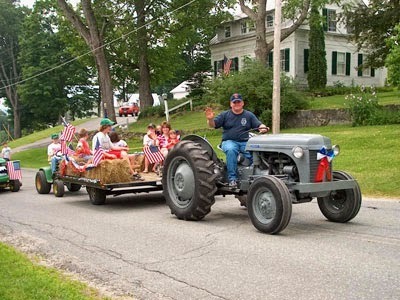 Peacham is considered one of Vermont's most photographed towns -- in part because at least one Vermont Life photographer lives there, and many more have visited. It's not just the hill-and-vale arrangement of church, town center, and farms that's drawn photographers here, but also the strands of local tradition and history. The Peacham Historical Society is constructing new climate-controlled storage space for its archives; the Peacham Library hosts a weekly coffee hour; and the town's small school is neighbor to a professional-level astronomy observatory.
Peacham is considered one of Vermont's most photographed towns -- in part because at least one Vermont Life photographer lives there, and many more have visited. It's not just the hill-and-vale arrangement of church, town center, and farms that's drawn photographers here, but also the strands of local tradition and history. The Peacham Historical Society is constructing new climate-controlled storage space for its archives; the Peacham Library hosts a weekly coffee hour; and the town's small school is neighbor to a professional-level astronomy observatory.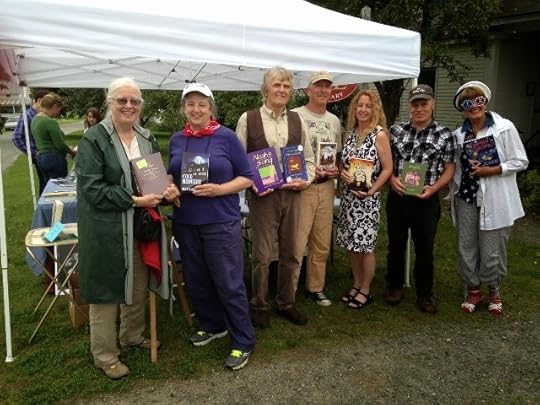 Seven of us "local authors" joined the Peacham Library on July 4, to focus some interest on books. There was a sale of used books inside the library, and outside, under a tent, we seven offered copies of our creations, along with signatures of course. Since business was slow, we also had plenty of opportunity to share aspects of both research and the writing life with each other -- for instance, we listened to Jerry Johnson's poems set to music and performed (on CD) by Jon Gailmore, while archivist Lynn Bonfield described the Gold Rush-era diary that brought her from California to Peacham, children's authors Lynda Graham-Barber and Tanya Sousa compared notes on their paths, Alec Hastings confirmed that he's now writing a teen adventure based on the river logging of the early 1900s, and memoirist Gary Schoolcraft and I planned more author collaborations.
Seven of us "local authors" joined the Peacham Library on July 4, to focus some interest on books. There was a sale of used books inside the library, and outside, under a tent, we seven offered copies of our creations, along with signatures of course. Since business was slow, we also had plenty of opportunity to share aspects of both research and the writing life with each other -- for instance, we listened to Jerry Johnson's poems set to music and performed (on CD) by Jon Gailmore, while archivist Lynn Bonfield described the Gold Rush-era diary that brought her from California to Peacham, children's authors Lynda Graham-Barber and Tanya Sousa compared notes on their paths, Alec Hastings confirmed that he's now writing a teen adventure based on the river logging of the early 1900s, and memoirist Gary Schoolcraft and I planned more author collaborations.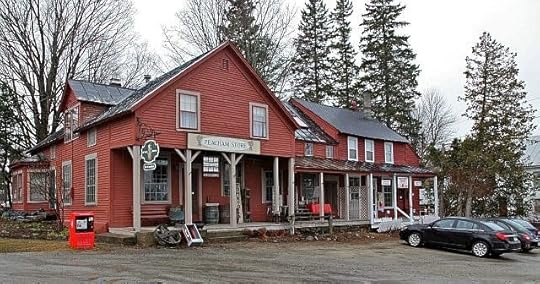 But equally of interest to me, especially as I reflect on overheard conversations that day, is how many media had roles in the day's offerings. Not only were we authors discussing printed books, e-books, and audio books, but we shared Internet research techniques and access. Young reporter Caleigh Cross (a novelist herself) captured images of the famous Peacham tractor parade for the local newspaper's advance website coverage. And visitors pointed to the village store buildings and talked about the films that have used them as backdrops, like Ethan Frome and The Spitfire Grill.
But equally of interest to me, especially as I reflect on overheard conversations that day, is how many media had roles in the day's offerings. Not only were we authors discussing printed books, e-books, and audio books, but we shared Internet research techniques and access. Young reporter Caleigh Cross (a novelist herself) captured images of the famous Peacham tractor parade for the local newspaper's advance website coverage. And visitors pointed to the village store buildings and talked about the films that have used them as backdrops, like Ethan Frome and The Spitfire Grill.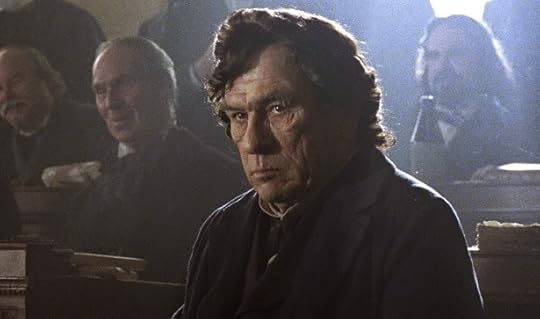 As for me, I was also thinking about Peacham history, "then" and now. I'm particularly pleased with the fresh interest locally in Thaddeus Stevens (1792-1868), who lived in Peacham as a child and became an ardent abolitionist and legislator based in Pennsylvania. The recent film Lincoln gave him a memorable face and role, played by Tommy Lee Jones. Just as important to me are the postcards Dave and I recently acquired, one showing an earlier view down "South Main Street" from where we authors stood, and the other of the house labeled here "Thad[deus] Stevens Farm."* These old postcards were the "social media" of their time, half Facebook-ish with their images, half Twitter-esque with the limited space for a message. As I collect these, along with memories of a congenial community event, I feel like a human version of a hyperlink, myself.
As for me, I was also thinking about Peacham history, "then" and now. I'm particularly pleased with the fresh interest locally in Thaddeus Stevens (1792-1868), who lived in Peacham as a child and became an ardent abolitionist and legislator based in Pennsylvania. The recent film Lincoln gave him a memorable face and role, played by Tommy Lee Jones. Just as important to me are the postcards Dave and I recently acquired, one showing an earlier view down "South Main Street" from where we authors stood, and the other of the house labeled here "Thad[deus] Stevens Farm."* These old postcards were the "social media" of their time, half Facebook-ish with their images, half Twitter-esque with the limited space for a message. As I collect these, along with memories of a congenial community event, I feel like a human version of a hyperlink, myself.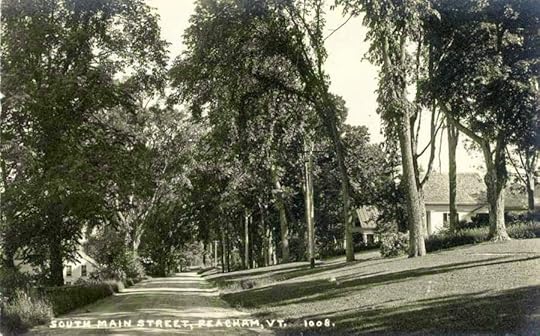
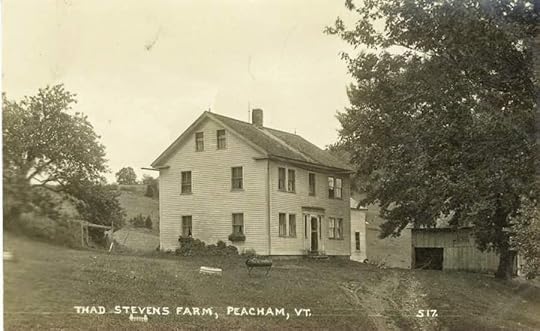
Our future is rooted in our past; how lovely to savor the present, and look in both of those directions.
*Note from archivist Lynn Bonfield: "The Stevens house on the hill (seen from the village) was the one he bought for his mother—he never lived there. He was raised in a house on the Peacham–Barnet border, up the hill from the West Barnet church."
Published on July 15, 2014 13:15
June 14, 2014
Buzzards at the Cemetery
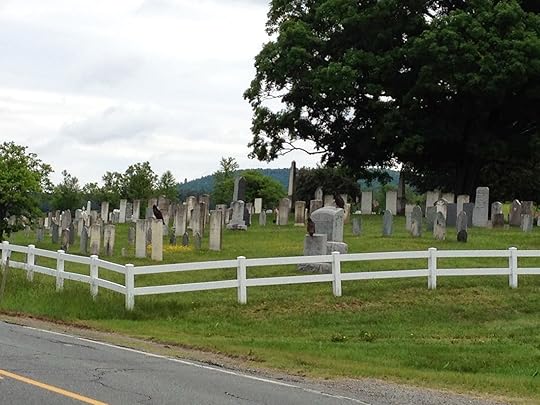 We made a delivery to friends in North Monroe, New Hampshire, this morning, then headed home on the "scenic route" -- which immediately had me slowing the van and stopping in the middle of the road, to watch the unusual sight of a large turkey buzzard perched on top of some "road kill" (a crushed and furry heap of smashed animal) and refusing to move. I wanted to take a photo but Dave was concerned that we were a target for other cars arriving, so I let the car roll slowly forward, and with a clearly resentful shrug, the buzzard left its prey and allowed us to pass. I parked just beyond the spot as I realized what I was seeing where the buzzard had landed: THREE enormous turkey buzzards sitting together on the stones of the North Monroe cemetery, waiting for another chance to consume their meal.
We made a delivery to friends in North Monroe, New Hampshire, this morning, then headed home on the "scenic route" -- which immediately had me slowing the van and stopping in the middle of the road, to watch the unusual sight of a large turkey buzzard perched on top of some "road kill" (a crushed and furry heap of smashed animal) and refusing to move. I wanted to take a photo but Dave was concerned that we were a target for other cars arriving, so I let the car roll slowly forward, and with a clearly resentful shrug, the buzzard left its prey and allowed us to pass. I parked just beyond the spot as I realized what I was seeing where the buzzard had landed: THREE enormous turkey buzzards sitting together on the stones of the North Monroe cemetery, waiting for another chance to consume their meal.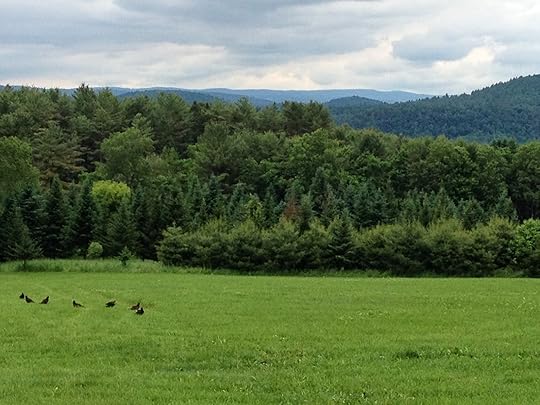 As I eased the car door open, stepped out, and closed the door most of the way, more buzzards landed in the field on the other side of the road. I have never seen such a large group of turkey buzzards -- I usually see them as two to four in a group, wheeling in the sky. What was drawing them?
As I eased the car door open, stepped out, and closed the door most of the way, more buzzards landed in the field on the other side of the road. I have never seen such a large group of turkey buzzards -- I usually see them as two to four in a group, wheeling in the sky. What was drawing them?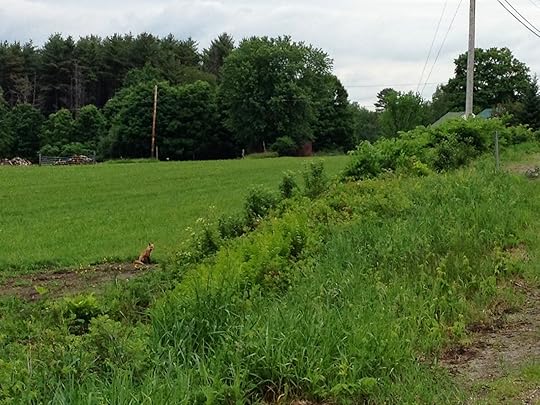 Next I realized that between the flock of birds of prey and the road, a small fox sat with its ears twitching. Fox kit (young one)? Or mama? I think probably the mama, since it watched the road intently. I raised the camera and caught a photo, but clearly was one threat too many, as the fox then stood up and trotted toward the road bank -- and vanished. Must be the fox den was under the edge of the road.
Next I realized that between the flock of birds of prey and the road, a small fox sat with its ears twitching. Fox kit (young one)? Or mama? I think probably the mama, since it watched the road intently. I raised the camera and caught a photo, but clearly was one threat too many, as the fox then stood up and trotted toward the road bank -- and vanished. Must be the fox den was under the edge of the road.So, what was holding the flock of buzzards in place? It can't have been the small tattered mound on the road. It was barely enough for one buzzard to consume. I'm thinking cow ... the field is part of a dairy farm, and either a cow went down, or a calf didn't survive the birthing process and is tucked under the green growth where I can't see it, but the turkey buzzards can.
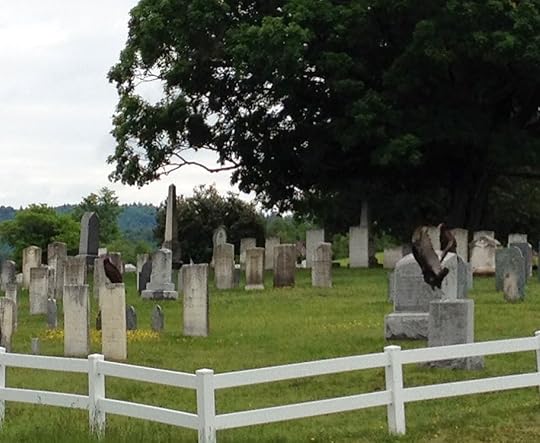 The birds perched on the cemetery stones became restless; you can see one here, toward the right, wings raised. I decided we should move on, and let them get back to bird business.
The birds perched on the cemetery stones became restless; you can see one here, toward the right, wings raised. I decided we should move on, and let them get back to bird business. What an unusual morning!
And that is how writers get distracted. But fear not: Sue Tester and I finished our "semifinal" draft of Charlie's Place a week ago, and my editor at the publishing house is taking a look. Two more sets of revisions to complete, before I can let myself launch into writing The Fire Curse. Chug, chug, chug, puff. I think I can ...
Published on June 14, 2014 10:47
April 30, 2014
Learning from Common Core Standards While Revising CHARLIE'S PLACE
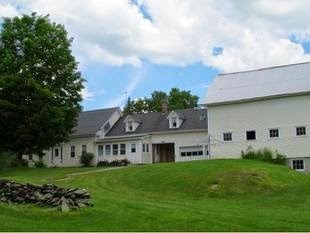 This Vermont home is like the one I picture for Charlie's new friend John.Yesterday and today have been revision days for one of my books in progress, Charlie's Place -- the third-grader story set at Ben Thresher's Mill in Barnet, Vermont, underway with co-author and teacher Sue Haven Tester. In addition to tightening the story and making the action as clear as possible, I've been following Sue's suggestion to wrestle with making the book's vocabulary more varied and rich. Along with this is the skill of embedding more challenging words in multiple ways in the text, so readers become familiar with their usage in varied context.
This Vermont home is like the one I picture for Charlie's new friend John.Yesterday and today have been revision days for one of my books in progress, Charlie's Place -- the third-grader story set at Ben Thresher's Mill in Barnet, Vermont, underway with co-author and teacher Sue Haven Tester. In addition to tightening the story and making the action as clear as possible, I've been following Sue's suggestion to wrestle with making the book's vocabulary more varied and rich. Along with this is the skill of embedding more challenging words in multiple ways in the text, so readers become familiar with their usage in varied context.Today's adults looking back fondly at Grade 3 may be surprised at the actions that third graders are expected to take as they read new material in school. This is part of what I see as the improvements we're invited to make in teaching, and therefore also in the books we write for the kids to enjoy: The Common Core State Standards (CCSS) are a teacher-led and state-by-state adopted set of goals to work toward, one after another, so that our graduating high school seniors can tackle life at an adult level. So, here's what third graders need to be doing with the story they're reading (in addition to enjoying it!):
Assess.Today I took great pleasure in reshaping this paragraph to develop text with more depth, including several ideas that Sue contributed:
Critique.
Formulate.
Hypothesize.
Cite evidence.
Develop logical arguments.
<!-- /* Font Definitions */ @font-face {font-family:"MS 明朝"; mso-font-charset:78; mso-generic-font-family:auto; mso-font-pitch:variable; mso-font-signature:1 134676480 16 0 131072 0;} @font-face {font-family:"MS 明朝"; mso-font-charset:78; mso-generic-font-family:auto; mso-font-pitch:variable; mso-font-signature:1 134676480 16 0 131072 0;} /* Style Definitions */ p.MsoNormal, li.MsoNormal, div.MsoNormal {mso-style-unhide:no; mso-style-qformat:yes; mso-style-parent:""; margin:0in; margin-bottom:.0001pt; mso-pagination:widow-orphan; font-size:12.0pt; font-family:"Times New Roman"; mso-fareast-font-family:"MS 明朝"; mso-fareast-theme-font:minor-fareast;} .MsoChpDefault {mso-style-type:export-only; mso-default-props:yes; font-size:10.0pt; mso-ansi-font-size:10.0pt; mso-bidi-font-size:10.0pt; mso-fareast-font-family:"MS 明朝"; mso-fareast-theme-font:minor-fareast; mso-fareast-language:JA;} @page WordSection1 {size:8.5in 11.0in; margin:1.0in 1.25in 1.0in 1.25in; mso-header-margin:.5in; mso-footer-margin:.5in; mso-paper-source:0;} div.WordSection1 {page:WordSection1;} </style> <br /><blockquote class="tr_bq"><div class="MsoNormal" style="line-height: 200%;">Charlie looked way up at that boy’s face and worried. The boy made clown-like faces. He pushed close to John and said more things. John covered his ears. John said No! Charlie got angry. The mean boy was scaring John. Charlie hit the massive boy. Stop! No!</div></blockquote>But I also paid attention to this passage, weaving back into the text some special terms I'd introduced earlier:<br /><blockquote class="tr_bq"><style><!-- /* Font Definitions */ @font-face {font-family:"MS 明朝"; mso-font-charset:78; mso-generic-font-family:auto; mso-font-pitch:variable; mso-font-signature:1 134676480 16 0 131072 0;} @font-face {font-family:"Cambria Math"; panose-1:2 4 5 3 5 4 6 3 2 4; mso-font-charset:0; mso-generic-font-family:auto; mso-font-pitch:variable; mso-font-signature:-536870145 1107305727 0 0 415 0;} /* Style Definitions */ p.MsoNormal, li.MsoNormal, div.MsoNormal {mso-style-unhide:no; mso-style-qformat:yes; mso-style-parent:""; margin:0in; margin-bottom:.0001pt; mso-pagination:widow-orphan; font-size:12.0pt; font-family:"Times New Roman"; mso-fareast-font-family:"MS 明朝"; mso-fareast-theme-font:minor-fareast;} .MsoChpDefault {mso-style-type:export-only; mso-default-props:yes; font-size:10.0pt; mso-ansi-font-size:10.0pt; mso-bidi-font-size:10.0pt; mso-fareast-font-family:"MS 明朝"; mso-fareast-theme-font:minor-fareast; mso-fareast-language:JA;} @page WordSection1 {size:8.5in 11.0in; margin:1.0in 1.25in 1.0in 1.25in; mso-header-margin:.5in; mso-footer-margin:.5in; mso-paper-source:0;} div.WordSection1 {page:WordSection1;} </style> <span style="font-family: "Times New Roman"; font-size: 12.0pt; mso-ansi-language: EN-US; mso-bidi-language: AR-SA; mso-fareast-font-family: "MS 明朝"; mso-fareast-language: EN-US; mso-fareast-theme-font: minor-fareast;">There was water everywhere, with pieces of wood floating in it. It was too dark to see the turbine or the penstock, but the little bit of light flickered on the moving water. Was Old Ben shining a flashlight while he repaired the turbine? No, nobody could fix things in the cellar with this much water, not even Old Ben. The stairs kept shaking. Now Charlie felt scared.</span><span style="font-family: inherit;"><span style="font-size: 12.0pt; mso-ansi-language: EN-US; mso-bidi-language: AR-SA; mso-fareast-font-family: "MS 明朝"; mso-fareast-language: EN-US; mso-fareast-theme-font: minor-fareast;"> </span></span></blockquote><span style="font-family: inherit;"><span style="font-size: 12.0pt; mso-ansi-language: EN-US; mso-bidi-language: AR-SA; mso-fareast-font-family: "MS 明朝"; mso-fareast-language: EN-US; mso-fareast-theme-font: minor-fareast;">And it was also a good day to outline the nonfiction material for the end of the book, where (me being me) I suggested a timeline to organize the information and investigations that readers might add to their experience of the story. </span></span><br /><br /><span style="font-family: inherit;"><span style="font-size: 12.0pt; mso-ansi-language: EN-US; mso-bidi-language: AR-SA; mso-fareast-font-family: "MS 明朝"; mso-fareast-language: EN-US; mso-fareast-theme-font: minor-fareast;">Have you guessed yet from the way the text paragraphs here are written? Charlie is deaf ... at age eight, in about 1956 in Vermont. Things were very different then. I'm enjoying painting in the details, along with things that haven't changed at all, like the chest-quivering sensation of thunder, the comfort of morning pancakes with Grandma, and the satisfaction that comes from being as brave as possible, in a scary situation. Know what I mean? </span></span>
Published on April 30, 2014 10:56
April 29, 2014
Learning the Downy Woodpecker's Call(s): Why That Matters in Writing Today
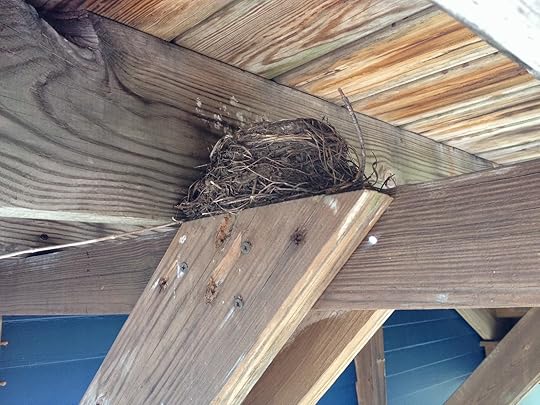 I watch for when this spring's robins start tidying up last year's nest.Walk for 20 minutes in the morning and your brain lights up with oxygen delivery in the areas that feed the writing process. The brain scans are quite clear about this effect!
I watch for when this spring's robins start tidying up last year's nest.Walk for 20 minutes in the morning and your brain lights up with oxygen delivery in the areas that feed the writing process. The brain scans are quite clear about this effect!But it's a bit more complicated to say why I am so excited that I learned the call of the downy woodpecker a few days ago. (You can hear it -- in fact, you can hear three different calls, the "pik," the "whinny," and the "drum" -- on the Cornell University ornithology site: http://www.allaboutbirds.org/guide/downy_woodpecker/sounds.) When I first starting trying to notice birds more deliberately, I realized I had an odd assumption left from childhood: If I already recognized a bird by its plumage and knew its name, I believed the bird was "common." And if it was new to me, I assumed it was "rare" because I hadn't become acquainted with it before. Wow, was I wrong! The birds I already "knew" turned out to be the ones my mom could name, so she taught them to me when I was a child: robin, sparrow, chickadee, bluebird, cardinal. My mom always wanted to see a hummingbird, but never had, and she considered them exotic.
Turns out that hummingbirds are common! I can see a dozen or more in a summer, now that I pay attention to them. So are woodpeckers, and in the trees around my home there are downy woodpeckers and pileated woodpeckers (the ones that remind me most of "Woody Woodpecker" from cartoons, because of the tall red crest of feathers on their heads). I think there are hairy woodpeckers, too, but I'm not yet good at differentiating them from the downy ones.
How do you learn to "see" a woodpecker? For me, it came from learning to hear one! Not just the rap of the beak on the tree -- that could be any of the three I've named, or even a "sapsucker" (more on those, another day). But the downy woodpecker has a distinctive call, and if I notice it and look up right away, it's so easy to see the black-and-white bird after all.
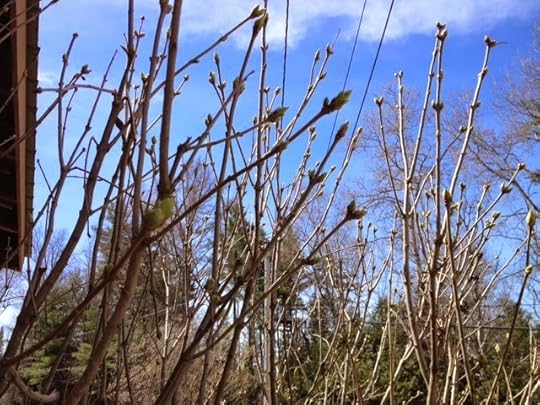 How different a lilac bud looks, compared to the eventual flowers!Bringing the invisible, the unnoticed, the mysterious and marvelous, into a poem or novel makes a huge different to how vivid and memorable the writing becomes. It also helps me reach more fullness of characters, and to question, in the best of ways, why I'm choosing a particular path for a work. So each day, on my 20-minute walk, I question what I'm seeing and hearing, asking names, changes, explanations, and yes, seeking the invisible within the story at the same time. It matters to me.
How different a lilac bud looks, compared to the eventual flowers!Bringing the invisible, the unnoticed, the mysterious and marvelous, into a poem or novel makes a huge different to how vivid and memorable the writing becomes. It also helps me reach more fullness of characters, and to question, in the best of ways, why I'm choosing a particular path for a work. So each day, on my 20-minute walk, I question what I'm seeing and hearing, asking names, changes, explanations, and yes, seeking the invisible within the story at the same time. It matters to me.
Published on April 29, 2014 08:09
March 16, 2014
When My Grandson Was 4, and Other Common Core Standards Reflections on Writing
When I know there's going to be some writing time fitted into my day, I'm elated. I race to get the newspapers for my husband's morning, sing as I swing through kitchen chores, and struggle to stay "on task" for the day's other labors, heading toward the magic hour I've promised myself.A real papermill, like the ones in the book my grandson read.... Waiting for supper is short but your stomach rumbles like the mill does. (from Charlie's Place, in second draft)
It's "rich vocabulary" day. I'm planning to go through chapter 4 of the first draft of Charlie's Place, the book my teacher-co-author Sue Tester and I are writing for third graders. Sue, a teacher, has already "tested" the chapter with some students, and they're on board -- they've embraced Charlie, with his challenges and his eight-year-old courage. In other words, our plot and character are strong and we're confident in them. So the next step is to test every sentence, looking for how much we can evoke with the words we are choosing. Sue has penciled her suggestions for where we can push the wording to be more precise and to ask more of our future third-grade readers.
And that, to me, is where my own "take" on the Common Core Standards -- that they are daring us writers to lure kids into growth, so they'll be able to reach adult levels by grade 12 -- gives an exhilarating push to what fascinates me, the power of story to reach all of us. I want to make Charlie's Place into the best possible story, and that means endowing it with words that matter.
In fact, as it's now written, the first paragraph of this "chapter book" introduces a word that most third-graders won't yet know. Most adult readers won't know it, either. Penstock. It's an important piece of the out-of-sight machinery of a working river mill, and how Charlie interacts with the way the river water pounds through the penstock tells something important about this boy. And it gets us moving into the mill itself, with its intricate and sometimes dangerous machinery.
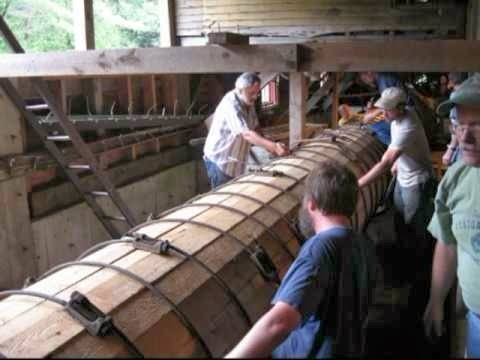 Volunteers reconstruct the penstock at Ben's Mill, Barnet, Vermont.
Volunteers reconstruct the penstock at Ben's Mill, Barnet, Vermont.
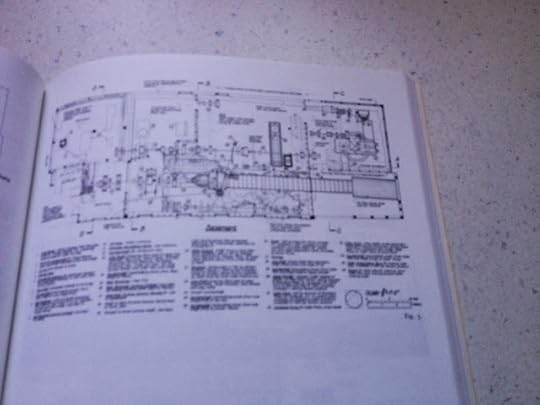 (The penstock is at the heart of this diagram -- looks like a giant wooden screw the way it's drawn.)
(The penstock is at the heart of this diagram -- looks like a giant wooden screw the way it's drawn.)This brings me to my grandson Ian, who was only four years old, living in a major city, when he asked me on the phone one day, "Grandma, do you know about paper mills?"
The mill in Charlie's Place is for making items out of wood and metal, and I know it very well, but yes, I also do know about paper mills -- not quite as much, but I've been inside a couple of them. Ian and I had a great conversation about paper mills. At age four, thanks to his teacher and his mom and dad, Ian already knew a lot about how trees become pulp and pulp becomes paper, and what a mill looks like. And he knew there would be REAL paper mills up here in Vermont. His folks and I opted to not take him to a paper mill last summer, because they are incredibly noisy and scary, even for adults. But it's something we'll do later. Meanwhile, what I carry into today's revision is this: At age four, you can be fascinated by complexity and detail, and you can learn the words that go with it.
And then you are rewarded with conversations that are memorable, and images that stay with you. You savor the richness of your experience. And you can do this at age four!! and eight!!! and while you are working on revisions of the book that's meant for those kids, and for the teachers and parents who'll accompany them on their books journeys.
See what I mean about writing time? I am SO ready for this day.
PS -- Interested in how "rich vocabulary" gets introduced? Check out the kids' novel Hope Is a Ferris Wheel by Robin Herrera (my enthusiastic review of it here): There are actual lists of "use-this-word-in-a-sentence" assignments that make up part of the plot. I especially loved the way the trailer-park life of the protagonist makes her wrestle with the word derelict.
Published on March 16, 2014 07:04
February 21, 2014
Learning the Words: The Common Core Standards and Joyful Writing
 "Scaffolding."It's easy to think of the Common Core State Standards as something "for teachers" and not for the rest of us. The newspaper coverage emphasizing the standards as related to testing, for instance -- and if you're a writer who has finished your official schooling, testing is something you're probably not going to embrace.
"Scaffolding."It's easy to think of the Common Core State Standards as something "for teachers" and not for the rest of us. The newspaper coverage emphasizing the standards as related to testing, for instance -- and if you're a writer who has finished your official schooling, testing is something you're probably not going to embrace.On the other hand, there's an aspect of the Common Core that is making my heart leap with excitement. Yes, really. Here it is: As I understand them, the new standards are saying: "By the time students leave high school, they'll be reading and processing information at an adult level."
To me, that makes good sense -- I want the kids coming out of high school and going straight to the workforce to be able to do so as adults, and even more so, I hope that those teens entering college can do it as adults. When I think about the differences among the college students I know, in terms of who is making the most of the opportunity and who is blowing it off, it boils down to exactly this.
When I pair this idea with "scaffolding" -- a term I learned from a reading teacher, at a workshop maybe 20 years ago -- the role of "young adult" fiction in the classroom becomes more complex and interesting. Not only are we giving readers a chance to experience, vicariously, the challenges, fears, and courage of life; we are also helping them rise up, one grade at a time, to being effective and joyful participants in the world of adults. We build a "scaffold" the way house painters or skyscraper builders do, so we can boost readers upward from where they already stand.
How do we do this? Here's my vocab lesson for the day, teaching myself the ways that teachers are now talking about the process, within the Common Core standards, in terms of the writer's own favorite building blocks: words.
Tier 1 words: These words are basic vocabulary or the more common words most children will know. They include high-frequency words and usually are not multiple meaning words.We who are writing YA fiction -- whether it's mysteries or "literary" -- are invited by these standards to play with "Tier 2 words," the words that my teaching friends call "rich vocabulary." What a gift! What a delight! These are the words I've used in my poetry, always; now I'm being invited to use them deliberately and with skill, in everything else I'm writing for grades K to 12, and especially for middle grades and young adults.
Tier 2 words: Less familiar, yet useful vocabulary found in written text and shared between the teacher and student in conversation. The Common Core State Standards refers to these as “general academic words.” Sometimes they are referred to as “rich vocabulary.” These words are more precise or subtle forms of familiar words and include multiple meaning words. Instead of walk for example, saunter could be used. These words are found across a variety of domains.
Tier 3 words: CCSS refers to these words as “domain specific;” they are critical to understanding the concepts of the content taught in schools. Generally, they have low frequency use and are limited to specific knowledge domains. Examples would include words such as isotope, peninsula, refinery. They are best learned when teaching specific content lessons, and tend to be more common in informational text. (a nice version, well spelled out, from a commercial website, http://www.learninga-z.com)
See why my Writer's Heart is singing?
Published on February 21, 2014 12:05
Learning to Write Better, Because My Co-Author Teaches Third Grade
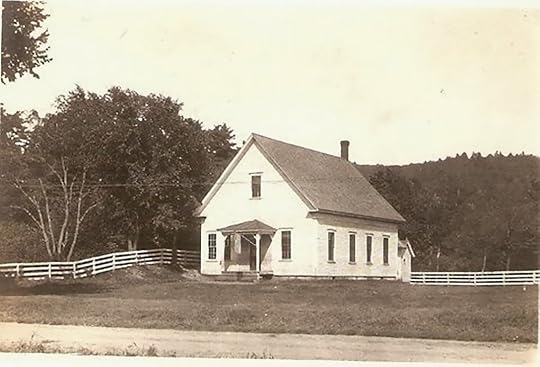 East Barnet Schoolhouse, courtesy Janice Boyko<!-- /* Font Definitions */ @font-face {font-family:"MS 明朝"; mso-font-charset:78; mso-generic-font-family:auto; mso-font-pitch:variable; mso-font-signature:-536870145 1791491579 18 0 131231 0;} @font-face {font-family:"Cambria Math"; panose-1:2 4 5 3 5 4 6 3 2 4; mso-font-charset:0; mso-generic-font-family:auto; mso-font-pitch:variable; mso-font-signature:-536870145 1107305727 0 0 415 0;} /* Style Definitions */ p.MsoNormal, li.MsoNormal, div.MsoNormal {mso-style-unhide:no; mso-style-qformat:yes; mso-style-parent:""; margin:0in; margin-bottom:.0001pt; mso-pagination:widow-orphan; font-size:12.0pt; font-family:"Times New Roman"; mso-fareast-font-family:"MS 明朝"; mso-fareast-theme-font:minor-fareast;} .MsoChpDefault {mso-style-type:export-only; mso-default-props:yes; font-size:10.0pt; mso-ansi-font-size:10.0pt; mso-bidi-font-size:10.0pt; mso-fareast-font-family:"MS 明朝"; mso-fareast-theme-font:minor-fareast; mso-fareast-language:JA;} @page WordSection1 {size:8.5in 11.0in; margin:1.0in 1.25in 1.0in 1.25in; mso-header-margin:.5in; mso-footer-margin:.5in; mso-paper-source:0;} div.WordSection1 {page:WordSection1;} </style> --> <span style="font-family: "Times New Roman"; font-size: 12.0pt; mso-ansi-language: EN-US; mso-bidi-language: AR-SA; mso-fareast-font-family: "MS 明朝"; mso-fareast-language: EN-US; mso-fareast-theme-font: minor-fareast;"><span class="userContent">I'm working on the second draft of CHARLIE'S PLACE, a book for third and fourth graders -- and my co-author, Sue Tester, is behind many of the details in this revision. (I wrote the first draft, based on our plotting and character sessions together.)</span></span><br /><span style="font-family: "Times New Roman"; font-size: 12.0pt; mso-ansi-language: EN-US; mso-bidi-language: AR-SA; mso-fareast-font-family: "MS 明朝"; mso-fareast-language: EN-US; mso-fareast-theme-font: minor-fareast;"><span class="userContent">Sue teach<span class="text_exposed_show">es grade 3 now and has taught others, and she taught me some Common Core Standards vocabulary to go with what we're now doing to the text: working on rich vocabulary that takes readers into the text. On my own, I then poked into Bloom's Taxonomy of Learning, Webb's Depth of Knowledge, technology in classroom learning ... </span></span></span><br /><br /><span style="font-family: "Times New Roman"; font-size: 12.0pt; mso-ansi-language: EN-US; mso-bidi-language: AR-SA; mso-fareast-font-family: "MS 明朝"; mso-fareast-language: EN-US; mso-fareast-theme-font: minor-fareast;"><span class="userContent"><span class="text_exposed_show">I also took a course this January on the "arc of the story," and it helped me zoom through my plot twists and focus on character in fresh ways. But Sue and I are writing the kind of book where every word matters. Partly that's because it's for younger readers. Partly it's because I care about words as a poet does. And now it's also because Sue is showing me how to carry this into her classroom effectively.</span></span></span><br /><br /><span style="font-family: "Times New Roman"; font-size: 12.0pt; mso-ansi-language: EN-US; mso-bidi-language: AR-SA; mso-fareast-font-family: "MS 明朝"; mso-fareast-language: EN-US; mso-fareast-theme-font: minor-fareast;"><span class="userContent"><span class="text_exposed_show">Some of this is new names and frames for what good writers/storytellers do, and all of it is pushing me to dig deeper, think harder, write better. </span></span>Here's a small example of the changes happening, as we take 8-year-old Charlie into school for his first time, around 1956:</span><br /><blockquote class="tr_bq"><span style="font-family: "Times New Roman"; font-size: 12.0pt; mso-ansi-language: EN-US; mso-bidi-language: AR-SA; mso-fareast-font-family: "MS 明朝"; mso-fareast-language: EN-US; mso-fareast-theme-font: minor-fareast;"><b>First draft:</b> Charlie looked around. Big windows made the schoolhouse very bright inside. Two windows had small screens at the bottom of them. Air from outside came to Charlie through the window screens.</span><br /><br /><span style="font-family: "Times New Roman"; font-size: 12.0pt; mso-ansi-language: EN-US; mso-bidi-language: AR-SA; mso-fareast-font-family: "MS 明朝"; mso-fareast-language: EN-US; mso-fareast-theme-font: minor-fareast;"> <style><!-- /* Font Definitions */ @font-face {font-family:"MS 明朝"; mso-font-charset:78; mso-generic-font-family:auto; mso-font-pitch:variable; mso-font-signature:-536870145 1791491579 18 0 131231 0;} @font-face {font-family:"Cambria Math"; panose-1:2 4 5 3 5 4 6 3 2 4; mso-font-charset:0; mso-generic-font-family:auto; mso-font-pitch:variable; mso-font-signature:-536870145 1107305727 0 0 415 0;} /* Style Definitions */ p.MsoNormal, li.MsoNormal, div.MsoNormal {mso-style-unhide:no; mso-style-qformat:yes; mso-style-parent:""; margin:0in; margin-bottom:.0001pt; mso-pagination:widow-orphan; font-size:12.0pt; font-family:"Times New Roman"; mso-fareast-font-family:"MS 明朝"; mso-fareast-theme-font:minor-fareast;} .MsoChpDefault {mso-style-type:export-only; mso-default-props:yes; font-size:10.0pt; mso-ansi-font-size:10.0pt; mso-bidi-font-size:10.0pt; mso-fareast-font-family:"MS 明朝"; mso-fareast-theme-font:minor-fareast; mso-fareast-language:JA;} @page WordSection1 {size:8.5in 11.0in; margin:1.0in 1.25in 1.0in 1.25in; mso-header-margin:.5in; mso-footer-margin:.5in; mso-paper-source:0;} div.WordSection1 {page:WordSection1;} </style></span></blockquote>--> <span style="font-family: "Times New Roman"; font-size: 12.0pt; mso-ansi-language: EN-US; mso-bidi-language: AR-SA; mso-fareast-font-family: "MS 明朝"; mso-fareast-language: EN-US; mso-fareast-theme-font: minor-fareast;"><b>Second draft: </b>Charlie looked around. Big windows made the schoolhouse very bright inside. Two windows had small screens at the bottom of them. Charlie noticed the late summer breeze slipping into the room. Some of the outdoors came inside this way. Good.</span> <span style="font-family: "Times New Roman"; font-size: 12.0pt; mso-ansi-language: EN-US; mso-bidi-language: AR-SA; mso-fareast-font-family: "MS 明朝"; mso-fareast-language: EN-US; mso-fareast-theme-font: minor-fareast;">It's exciting for me to see my own writing and revision process as part of what's happening in US classrooms where teachers are using the new Common Core standards. I like this chart from teaching coach Tracy Watanabe (<a href="http://wwwatanabe.blogspot.com/"...), showing the deliberate changes that teachers are aiming for.</span><br /><br /><div class="separator" style="clear: both; text-align: center;"><a href="http://1.bp.blogspot.com/-Qyzvf6Kv2sI..." imageanchor="1" style="margin-left: 1em; margin-right: 1em;"><img border="0" src="http://1.bp.blogspot.com/-Qyzvf6Kv2sI..." height="300" width="400" /></a></div><br /><span style="font-family: "Times New Roman"; font-size: 12.0pt; mso-ansi-language: EN-US; mso-bidi-language: AR-SA; mso-fareast-font-family: "MS 明朝"; mso-fareast-language: EN-US; mso-fareast-theme-font: minor-fareast;">PS to Barnet, Vermont, and Ben's Mill readers and fans: The East Barnet schoolhouse photo is a good one, a bit earlier than the time when this story takes place. I'm actually picturing for the story the West Barnet schoolhouse, which, when I moved to town in 1986, was the home of K&M Sales and I believe had been a Grange hall as well. If you have photos, I'd love to see them! </span>
East Barnet Schoolhouse, courtesy Janice Boyko<!-- /* Font Definitions */ @font-face {font-family:"MS 明朝"; mso-font-charset:78; mso-generic-font-family:auto; mso-font-pitch:variable; mso-font-signature:-536870145 1791491579 18 0 131231 0;} @font-face {font-family:"Cambria Math"; panose-1:2 4 5 3 5 4 6 3 2 4; mso-font-charset:0; mso-generic-font-family:auto; mso-font-pitch:variable; mso-font-signature:-536870145 1107305727 0 0 415 0;} /* Style Definitions */ p.MsoNormal, li.MsoNormal, div.MsoNormal {mso-style-unhide:no; mso-style-qformat:yes; mso-style-parent:""; margin:0in; margin-bottom:.0001pt; mso-pagination:widow-orphan; font-size:12.0pt; font-family:"Times New Roman"; mso-fareast-font-family:"MS 明朝"; mso-fareast-theme-font:minor-fareast;} .MsoChpDefault {mso-style-type:export-only; mso-default-props:yes; font-size:10.0pt; mso-ansi-font-size:10.0pt; mso-bidi-font-size:10.0pt; mso-fareast-font-family:"MS 明朝"; mso-fareast-theme-font:minor-fareast; mso-fareast-language:JA;} @page WordSection1 {size:8.5in 11.0in; margin:1.0in 1.25in 1.0in 1.25in; mso-header-margin:.5in; mso-footer-margin:.5in; mso-paper-source:0;} div.WordSection1 {page:WordSection1;} </style> --> <span style="font-family: "Times New Roman"; font-size: 12.0pt; mso-ansi-language: EN-US; mso-bidi-language: AR-SA; mso-fareast-font-family: "MS 明朝"; mso-fareast-language: EN-US; mso-fareast-theme-font: minor-fareast;"><span class="userContent">I'm working on the second draft of CHARLIE'S PLACE, a book for third and fourth graders -- and my co-author, Sue Tester, is behind many of the details in this revision. (I wrote the first draft, based on our plotting and character sessions together.)</span></span><br /><span style="font-family: "Times New Roman"; font-size: 12.0pt; mso-ansi-language: EN-US; mso-bidi-language: AR-SA; mso-fareast-font-family: "MS 明朝"; mso-fareast-language: EN-US; mso-fareast-theme-font: minor-fareast;"><span class="userContent">Sue teach<span class="text_exposed_show">es grade 3 now and has taught others, and she taught me some Common Core Standards vocabulary to go with what we're now doing to the text: working on rich vocabulary that takes readers into the text. On my own, I then poked into Bloom's Taxonomy of Learning, Webb's Depth of Knowledge, technology in classroom learning ... </span></span></span><br /><br /><span style="font-family: "Times New Roman"; font-size: 12.0pt; mso-ansi-language: EN-US; mso-bidi-language: AR-SA; mso-fareast-font-family: "MS 明朝"; mso-fareast-language: EN-US; mso-fareast-theme-font: minor-fareast;"><span class="userContent"><span class="text_exposed_show">I also took a course this January on the "arc of the story," and it helped me zoom through my plot twists and focus on character in fresh ways. But Sue and I are writing the kind of book where every word matters. Partly that's because it's for younger readers. Partly it's because I care about words as a poet does. And now it's also because Sue is showing me how to carry this into her classroom effectively.</span></span></span><br /><br /><span style="font-family: "Times New Roman"; font-size: 12.0pt; mso-ansi-language: EN-US; mso-bidi-language: AR-SA; mso-fareast-font-family: "MS 明朝"; mso-fareast-language: EN-US; mso-fareast-theme-font: minor-fareast;"><span class="userContent"><span class="text_exposed_show">Some of this is new names and frames for what good writers/storytellers do, and all of it is pushing me to dig deeper, think harder, write better. </span></span>Here's a small example of the changes happening, as we take 8-year-old Charlie into school for his first time, around 1956:</span><br /><blockquote class="tr_bq"><span style="font-family: "Times New Roman"; font-size: 12.0pt; mso-ansi-language: EN-US; mso-bidi-language: AR-SA; mso-fareast-font-family: "MS 明朝"; mso-fareast-language: EN-US; mso-fareast-theme-font: minor-fareast;"><b>First draft:</b> Charlie looked around. Big windows made the schoolhouse very bright inside. Two windows had small screens at the bottom of them. Air from outside came to Charlie through the window screens.</span><br /><br /><span style="font-family: "Times New Roman"; font-size: 12.0pt; mso-ansi-language: EN-US; mso-bidi-language: AR-SA; mso-fareast-font-family: "MS 明朝"; mso-fareast-language: EN-US; mso-fareast-theme-font: minor-fareast;"> <style><!-- /* Font Definitions */ @font-face {font-family:"MS 明朝"; mso-font-charset:78; mso-generic-font-family:auto; mso-font-pitch:variable; mso-font-signature:-536870145 1791491579 18 0 131231 0;} @font-face {font-family:"Cambria Math"; panose-1:2 4 5 3 5 4 6 3 2 4; mso-font-charset:0; mso-generic-font-family:auto; mso-font-pitch:variable; mso-font-signature:-536870145 1107305727 0 0 415 0;} /* Style Definitions */ p.MsoNormal, li.MsoNormal, div.MsoNormal {mso-style-unhide:no; mso-style-qformat:yes; mso-style-parent:""; margin:0in; margin-bottom:.0001pt; mso-pagination:widow-orphan; font-size:12.0pt; font-family:"Times New Roman"; mso-fareast-font-family:"MS 明朝"; mso-fareast-theme-font:minor-fareast;} .MsoChpDefault {mso-style-type:export-only; mso-default-props:yes; font-size:10.0pt; mso-ansi-font-size:10.0pt; mso-bidi-font-size:10.0pt; mso-fareast-font-family:"MS 明朝"; mso-fareast-theme-font:minor-fareast; mso-fareast-language:JA;} @page WordSection1 {size:8.5in 11.0in; margin:1.0in 1.25in 1.0in 1.25in; mso-header-margin:.5in; mso-footer-margin:.5in; mso-paper-source:0;} div.WordSection1 {page:WordSection1;} </style></span></blockquote>--> <span style="font-family: "Times New Roman"; font-size: 12.0pt; mso-ansi-language: EN-US; mso-bidi-language: AR-SA; mso-fareast-font-family: "MS 明朝"; mso-fareast-language: EN-US; mso-fareast-theme-font: minor-fareast;"><b>Second draft: </b>Charlie looked around. Big windows made the schoolhouse very bright inside. Two windows had small screens at the bottom of them. Charlie noticed the late summer breeze slipping into the room. Some of the outdoors came inside this way. Good.</span> <span style="font-family: "Times New Roman"; font-size: 12.0pt; mso-ansi-language: EN-US; mso-bidi-language: AR-SA; mso-fareast-font-family: "MS 明朝"; mso-fareast-language: EN-US; mso-fareast-theme-font: minor-fareast;">It's exciting for me to see my own writing and revision process as part of what's happening in US classrooms where teachers are using the new Common Core standards. I like this chart from teaching coach Tracy Watanabe (<a href="http://wwwatanabe.blogspot.com/"...), showing the deliberate changes that teachers are aiming for.</span><br /><br /><div class="separator" style="clear: both; text-align: center;"><a href="http://1.bp.blogspot.com/-Qyzvf6Kv2sI..." imageanchor="1" style="margin-left: 1em; margin-right: 1em;"><img border="0" src="http://1.bp.blogspot.com/-Qyzvf6Kv2sI..." height="300" width="400" /></a></div><br /><span style="font-family: "Times New Roman"; font-size: 12.0pt; mso-ansi-language: EN-US; mso-bidi-language: AR-SA; mso-fareast-font-family: "MS 明朝"; mso-fareast-language: EN-US; mso-fareast-theme-font: minor-fareast;">PS to Barnet, Vermont, and Ben's Mill readers and fans: The East Barnet schoolhouse photo is a good one, a bit earlier than the time when this story takes place. I'm actually picturing for the story the West Barnet schoolhouse, which, when I moved to town in 1986, was the home of K&M Sales and I believe had been a Grange hall as well. If you have photos, I'd love to see them! </span>
Published on February 21, 2014 10:29
February 14, 2014
Picturing World War I: Getting Ready for June 2014
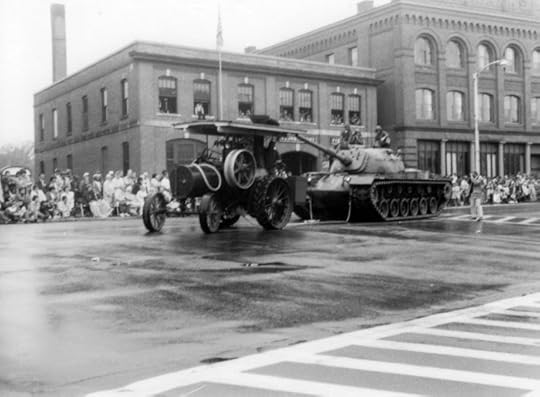 Tank on Main St, St Johnsbury, 1970June 29, 2014, will mark 100 years since the day Archduke Franz Ferdinand was killed by a shooter in Sarajevo -- touching off what would become known as the Great War, the War to End All Wars, and (ironically) World War I, since the peace at the end of this war failed to hold. In many ways, it marks the start of "modern history." And, for me, it's also the war that Claire's father returns from in 1921 in my Vermont adventure novel
Cold Midnight
, handicapped by the psychological illness then called "shell shock" (and rarely treated). It's also a war in which one of my great-grandfathers, Ludwig Ollendorf, was a soldier in Europe.
Tank on Main St, St Johnsbury, 1970June 29, 2014, will mark 100 years since the day Archduke Franz Ferdinand was killed by a shooter in Sarajevo -- touching off what would become known as the Great War, the War to End All Wars, and (ironically) World War I, since the peace at the end of this war failed to hold. In many ways, it marks the start of "modern history." And, for me, it's also the war that Claire's father returns from in 1921 in my Vermont adventure novel
Cold Midnight
, handicapped by the psychological illness then called "shell shock" (and rarely treated). It's also a war in which one of my great-grandfathers, Ludwig Ollendorf, was a soldier in Europe.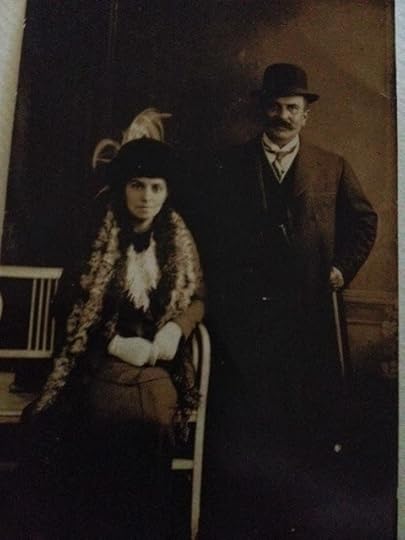 Regina and Ludwig Ollendorf[TEACHERS: How far do you need to go in your life history or your family history to find a connection to World War I? How can you help your students "picture" when this happened?]
Regina and Ludwig Ollendorf[TEACHERS: How far do you need to go in your life history or your family history to find a connection to World War I? How can you help your students "picture" when this happened?] So I'm thinking about Sarajevo more this year, trying to get a sense of where it was and what made it the trigger point for this enormous conflict. I found the city's own current website, http://www.sarajevo.ba/en; then I browsed the Wikipedia entry for a first look at context: http://en.wikipedia.org/wiki/Sarajevo -- wow, this city really exemplifies a quality I think of as especially American, the determination to be independent and control your own fate ... but it hasn't had a lot of time to do that!
Somewhat to my surprise, I rediscovered that a book on my shelf, People of the Book by Geraldine Brooks, involves Sarajevo -- I'll have to go back to it and think again about what this means to me.
But for today, I want to focus on learning and remembering exactly where Sarajevo is now: It's the capital of the linked nations of Bosnia and Herzegovina. And that body of water showing in the map here is the Adriatic Sea -- which runs along the "right-hand side" of Italy on the world map. It looks like the city is surrounded by gorgeous terrain, full of rivers and mountains ... and right next to Montenegro, for which mystery fans of the Rex Stout/Nero Wolfe books will have their own inner image! Another book I loved that's associated with this region is Lawrence Durrell's White Eagles Over Serbia.
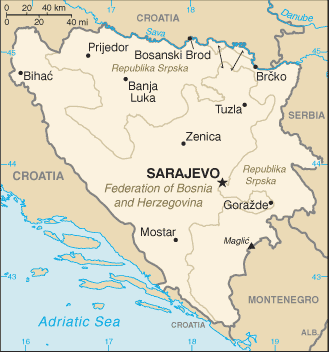
This is how I build "memorable history" for myself: I investigate for a bit, and find the parts of my life and my reading that connect to what I'm learning. Is that the way you do it, for yourself? If you are a parent or teacher or librarian, how do you show others the ways to "get history inside you"?
Published on February 14, 2014 11:12
January 11, 2014
Authors Making Hard Choices: CODE NAME VERITY by Elizabeth Wein and More
Prize-winning World War II espionage from the point of view of a young woman working for the Allies and "accidentally" taken prisoner in France, CODE NAME VERITY (2012) is a "young adult" bestseller. It's also one of the most recommended mysteries for adults to read in this genre. I enjoyed it very much and appreciated Elizabeth Wein's care with the history as well as with the emotion veracity of the fiction. Research and writing work together to give a vivid and, I think, trustworthy image of the time.
By coincidence, the same month I got around to reading it, I also read Fannie Flagg's newest novel, The All-Girl Filling Station's Last Reunion -- not in my usual genres, but the very local book group was reading it and invited me to share the process. To my delight, I found it overlapped the historical ground of Elizabeth Wein's book, just on the other side of the Atlantic. If you're interested in how women slowly but surely moved into flying planes during that war, read both.
Best of all, for those of us wrestling on a daily basis with writing -- or evaluating -- mysteries that rely on other times and other cultures, here's a wonderful piece from Wein on "Authority and Authenticity." Her final line still gives me shivers: "Tell the world. For all the faults and flaws of my telling, I have no choice but to tell this story as best I can."
By coincidence, the same month I got around to reading it, I also read Fannie Flagg's newest novel, The All-Girl Filling Station's Last Reunion -- not in my usual genres, but the very local book group was reading it and invited me to share the process. To my delight, I found it overlapped the historical ground of Elizabeth Wein's book, just on the other side of the Atlantic. If you're interested in how women slowly but surely moved into flying planes during that war, read both.
Best of all, for those of us wrestling on a daily basis with writing -- or evaluating -- mysteries that rely on other times and other cultures, here's a wonderful piece from Wein on "Authority and Authenticity." Her final line still gives me shivers: "Tell the world. For all the faults and flaws of my telling, I have no choice but to tell this story as best I can."
Published on January 11, 2014 09:29
December 19, 2013
Vermont = White Bread State? Evidence Says, I Doubt It!
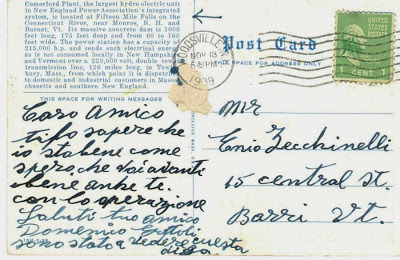 There was a card game we played as kids where you held out a card, hidden, and asserted it was a particular item -- say, a nine of diamonds. Another player could say "I doubt it!" I don't remember all the rules, but I know there were rewards for good bluffs, and rewards for seeing through them. Sometimes local history research feels like the same game.
There was a card game we played as kids where you held out a card, hidden, and asserted it was a particular item -- say, a nine of diamonds. Another player could say "I doubt it!" I don't remember all the rules, but I know there were rewards for good bluffs, and rewards for seeing through them. Sometimes local history research feels like the same game.At every chance I get, I search through old postcards in stores and antiquarian shows, looking for evidence of the "old days" in my part of Vermont. A few months ago I picked up a fairly common picture postcard of Comerford Dam (a Connecticut River dam that changed the history of my small town, Waterford, although it's actually anchored in Barnet VT and Monroe NH). On the back was the message shown here, written in laboriously penned Italian.
Teacher Meg Clayton majored in Italian in college, and she translated the card for me, confirming my guess that the writer had some issues with his written Italian -- maybe a working man, not often putting things on paper. I wanted very much to be able to show that the card traveled from a workman in the Northeast Kingdom around 1939, to another Italian speaker in the blue-collar granite town of Barre, Vermont. And some of the pieces are indeed here.
However, here's Meg's actual translation:
Dear Friend,When I added research into Italian family names in Vermont in 1939, I was able, with much excitement, to find the Zecchinelli family at 15 Central Street in Barre, in both the 1930 and 1940 Census documents. And I discovered that the postcard writer's surname was probably Zottoli, a family well spread through New England at the time.
I want you to know that I am well. I send well wishes to you with your operation.
Salutations from your friend,
Domenico Zittoli
I went to see this dam.
But I can't find any Zottoli in records of life in northern Vermont in 1939. So, in spite of what I wanted from this card, I have to conclude that Domenico Zottoli may have just been headed home after a visit to Mr. Zecchinelli, and passing through where the dam had recently been built.
Still, I'm not discouraged. This sign below, displayed by the Concord (VT) Historical Society, shows clearly that Italians lived and owned businesses in the Northeast Kingdom of Vermont in the early to mid 1900s.
And that's more evidence for what I'm painting into all of my writing: Vermont might look pretty darned white (especially in winter -- smile). But Vermonters have always been diverse. They answer the call to adventure, in many languages and styles. One hypothesis, not proved; the main theory, emphatically confirmed.
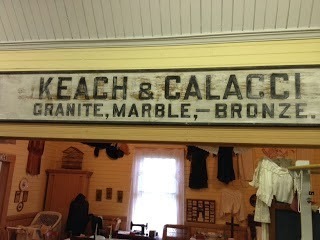
Published on December 19, 2013 10:14



